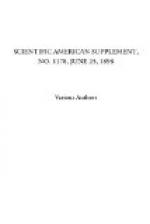If it were possible to examine the books of the several rubber reclaiming plants on this side of the border, including rubber shoe and mechanical goods factories producing their own reclaimed rubber, the percentage of this material used, in comparison with the total rubber consumption, might be found to be as great in the United States as in Canada. The rubber manufacture in the Dominion, in its inception, was practically an offshoot from the industry in this country. Our manufacturers supplied the Canadian demand for rubber goods until, under the stimulus of heavy protective duties, rubber works were established beyond the border, since which time, to quote a leader in the trade in the United States, “the methods of the Dominion rubber industry have mirrored the best practice in our country.” Hence it seems not unreasonable to conclude that if the Canadians are using so large a percentage of reclaimed rubber, they are doing no more nor less than the older and larger concerns here. The most trustworthy authorities place the consumption of new rubber in the United States during 1897 at not far from 35,000,000 pounds. Assuming that the rate of consumption of reclaimed rubber was as great as in Canada, we have 18,435,000 pounds more, or a total of 53,433,000 pounds. But there are producers of reclaimed rubber who insist that the amount of this material used in this country equals, pound for pound, the consumption of new rubber.
The use of reclaimed rubber in Europe is increasing gradually, and especially in Great Britain. The American product is sold extensively in that country, and some native reclaiming plants have been started. The most extensive “galosh” factory in Russia, which is said to be the largest in the world, is reclaiming rubber according to American methods. But, as a rule, the Continental rubber manufacturers make more use of “substitutes,” a class of materials which has not found favor in America. These rubber substitutes belong chiefly to the class of oxidized oils and may be classed in three divisions: Those obtained (1) by the action of oxygen or air on linseed oil; (2) by acting on rape oil with chloride of sulphur; and (3) by the action of sulphur on rape oil at a high temperature. The first class has little application to the rubber trade, though its use is universal in the linoleum industry. In Europe the chemist holds a more important position in the rubber manufacture than here, one result of which has been cheaper compounds of rubber and another the satisfactory employment of the refractory African rubbers long before they were used extensively in the United States. Hence the cost of raw materials in the rubber industry has been, on the whole, cheaper abroad. The Europeans have had an advantage, too, in respect to cheaper labor, which has offset somewhat our own advantage from the use of reclaimed rubber as a cheap material.




